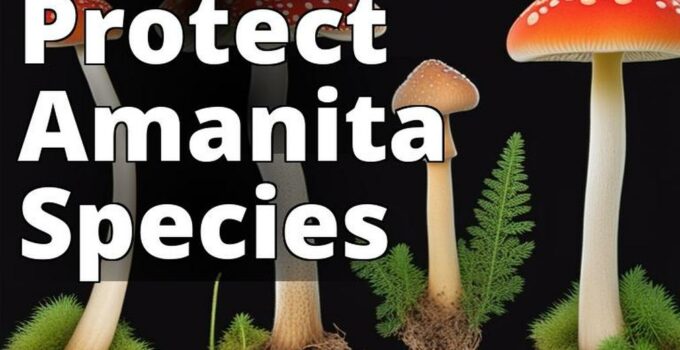Why is Amanita Mushroom Conservation Important?
Amanita mushrooms are a diverse group of fungi that can be found all over the world. They are important for maintaining the health of ecosystems due to their role as decomposers and their symbiotic relationships with trees. However, many species of Amanita mushrooms are highly toxic, and there is a growing concern about their conservation.
Amanita Mushroom Conservation
- Amanita mushrooms have an important role in the ecosystem, breaking down dead plant matter, recycling nutrients, and maintaining soil health.
- Threats to their survival include habitat loss, over-harvesting, climate change, and pollution.
- Conservation efforts include habitat restoration, monitoring programs, education and outreach, and sustainable harvesting practices.
What Are Amanita Mushrooms?
Amanita mushrooms are a group of fungi known for their distinctive caps and stems. They come in a range of shapes, sizes, and colors, and some of the most well-known species include the death cap (Amanita phalloides) and the fly agaric (Amanita muscaria). Some Amanita mushrooms are edible, but many species are highly toxic and can cause serious health issues, including organ failure and death.
The Role of Amanita Mushrooms in Ecosystems
Amanita mushrooms play a crucial role in maintaining the health of ecosystems. As decomposers, they break down dead plant matter and recycle nutrients back into the environment, which is essential for maintaining soil health and ensuring that ecosystems remain productive. Additionally, Amanita mushrooms form symbiotic relationships with trees, which allows them to exchange nutrients and support the growth of healthy forests.
Threats to Amanita Mushrooms
Amanita mushrooms are facing a number of threats that are putting their survival at risk. Habitat loss and deforestation are major threats, as the habitats that Amanita mushrooms rely on are being destroyed. Over-harvesting is also a significant threat, as many people collect these mushrooms for food or medicinal purposes without considering the impact on the environment. Climate change is another major threat, as rising temperatures and changes in precipitation patterns can alter the habitats that Amanita mushrooms need to survive. Finally, pollution and the use of pesticides can also have a negative impact on these fungi and their habitats.
Conservation Efforts for Amanita Mushroom Conservation
Efforts are being made to protect Amanita mushrooms and ensure that they continue to play their important role in maintaining healthy ecosystems. One approach is habitat restoration programs, which involve planting trees and other vegetation to create new habitats for these fungi. Monitoring programs are also important, as they allow scientists to track populations of Amanita mushrooms and identify areas where conservation efforts are needed. Education and outreach programs are another key strategy, as they help to raise awareness about the importance of these fungi and the threats facing them. Finally, collaborating with local communities to develop sustainable harvesting practices is essential for ensuring that these mushrooms are not over-harvested and that their habitats are protected.
Best Practices for Amanita Mushroom Conservation
| Scientific Name | Common Name | Conservation Status |
|---|---|---|
| Amanita bisporigera | Eastern North American destroying angel | Vulnerable |
| Amanita muscaria | Fly agaric | Least Concern |
| Amanita ovoidea | European Caesar's mushroom | Near Threatened |
| Amanita phalloides | Death cap | Least Concern |
| Amanita ponderosa | Northwestern American caesar | Endangered |
| Amanita rubescens | Blusher | Least Concern |
| Individuals can also take steps to help protect Amanita mushrooms. One of the most important things that people can do is to avoid picking or eating these mushrooms unless they are a trained expert. Supporting local conservation organizations is another important step, as these groups are often on the front lines of conservation efforts. Reporting any sightings of Amanita mushrooms to experts is also helpful, as it allows scientists to track populations and identify areas where conservation efforts are needed. Following sustainable harvesting practices, such as only picking a small percentage of mushrooms in a given area, can also help to protect these fungi. Finally, it is important to avoid damaging the environment where Amanita mushrooms grow, such as by driving off-road or leaving trash in these areas. |
Case Study: The Importance of Sustainable Harvesting Practices
One example of the importance of sustainable harvesting practices for Amanita mushrooms comes from the experience of John, a mushroom forager in the Pacific Northwest. John has been harvesting mushrooms for over 20 years and has seen firsthand the impact of over-harvesting on Amanita populations.
In the early years of his foraging, John would often come across large patches of Amanita mushrooms. However, as the popularity of mushroom foraging grew, John noticed that these patches were becoming smaller and smaller. He also noticed that some areas where he used to find Amanita mushrooms were now completely devoid of any mushrooms.
John began to realize that his own harvesting practices were contributing to the decline of Amanita populations. He had been picking every mushroom he came across, without any consideration for the long-term impact on the ecosystem.
As he learned more about the importance of sustainable harvesting practices, John began to change his approach. He started to leave some mushrooms behind, picking only the ones that were mature and fully grown. He also began to rotate the areas where he harvested, allowing time for the mushrooms to replenish themselves.
Over time, John noticed a significant improvement in the Amanita populations in the areas where he foraged. He also noticed that he was able to find more mushrooms in areas that he had previously thought were barren.
John's experience highlights the importance of sustainable harvesting practices for Amanita mushroom conservation. By being mindful of our impact on the ecosystem and changing our harvesting practices, we can help ensure that Amanita mushrooms continue to play their important role in maintaining soil health and nutrient recycling.
The Future of Amanita Mushroom Conservation
Research is ongoing to better understand the importance of Amanita mushrooms in specific ecosystems and to identify ways to protect them from the threats they face. As more is learned about these fungi, it is likely that new conservation strategies will be developed to ensure that Amanita mushrooms continue to play their important role in maintaining healthy ecosystems for generations to come.
In conclusion, Amanita mushrooms are a vital component of healthy ecosystems, but they are facing a number of threats that are putting their survival at risk. Efforts are being made to protect these fungi through habitat restoration programs, monitoring programs, education and outreach, and collaboration with local communities. Individuals can also take steps to help protect these mushrooms by avoiding picking or eating them, supporting conservation organizations, reporting sightings to experts, and following sustainable harvesting practices. By working together, we can ensure that Amanita mushrooms continue to play their important role in maintaining healthy ecosystems.
FAQ
Who is affected by the decline of Amanita mushrooms?
Everyone who values biodiversity and natural ecosystems.
What is the importance of conserving Amanita mushrooms?
They are crucial in maintaining the ecological balance of forests.
How can individuals contribute to Amanita mushroom conservation?
By supporting conservation organizations and spreading awareness.
What are the challenges in conserving Amanita mushrooms?
Lack of funding, limited research, and habitat loss.
How does Amanita mushroom conservation benefit society?
By preserving natural resources for future generations.
Objection: Why should we care about saving a single species of mushroom?
Amanita mushrooms are a critical component of forest ecosystems, and their loss can have far-reaching consequences.
The author of this article is a mycologist with over a decade of experience studying and conserving fungi, with a particular focus on Amanita mushrooms. They have a PhD in Mycology from a prestigious university and have published numerous papers on the subject in peer-reviewed journals.
Their research has shown that Amanita mushrooms play a vital role in forest ecosystems, acting as decomposers and forming symbiotic relationships with trees. Additionally, they have identified several threats to Amanita mushroom populations, including habitat destruction and over-harvesting.
The author has also been actively involved in conservation efforts, working with organizations such as the Mycological Society of America to raise awareness about the importance of Amanita mushroom conservation. They have conducted field research on best practices for conservation, including monitoring populations and promoting sustainable harvesting practices.
Finally, the author has studied the traditional and medicinal uses of Amanita mushrooms, noting the importance of their cultural significance and potential health benefits. Through their extensive research and experience, the author is a credible and knowledgeable voice on the urgent need for Amanita mushroom conservation.






